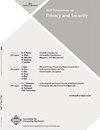Binsec/Rel: Symbolic Binary Analyzer for Security with Applications to Constant-Time and Secret-Erasure
IF 2.8
4区 计算机科学
Q2 COMPUTER SCIENCE, INFORMATION SYSTEMS
引用次数: 5
Abstract
This article tackles the problem of designing efficient binary-level verification for a subset of information flow properties encompassing constant-time and secret-erasure. These properties are crucial for cryptographic implementations but are generally not preserved by compilers. Our proposal builds on relational symbolic execution enhanced with new optimizations dedicated to information flow and binary-level analysis, yielding a dramatic improvement over prior work based on symbolic execution. We implement a prototype, Binsec/Rel, for bug-finding and bounded-verification of constant-time and secret-erasure and perform extensive experiments on a set of 338 cryptographic implementations, demonstrating the benefits of our approach. Using Binsec/Rel, we also automate two prior manual studies on preservation of constant-time and secret-erasure by compilers for a total of 4,148 and 1,156 binaries, respectively. Interestingly, our analysis highlights incorrect usages of volatile data pointer for secret-erasure and shows that scrubbing mechanisms based on volatile function pointers can introduce additional register spilling that might break secret-erasure. We also discovered that gcc -O0 and backend passes of clang introduce violations of constant-time in implementations that were previously deemed secure by a state-of-the-art constant-time verification tool operating at LLVM level, showing the importance of reasoning at binary level.Binsec/Rel:用于安全的符号二进制分析器,用于恒定时间和秘密擦除
本文解决了为包含恒定时间和秘密擦除的信息流属性子集设计有效的二进制级验证的问题。这些属性对于加密实现至关重要,但编译器通常不会保留这些属性。我们的建议建立在关系符号执行的基础上,增强了专门针对信息流和二进制级分析的新优化,比先前基于符号执行的工作产生了巨大的改进。我们实现了一个原型Binsec/Rel,用于bug查找和恒定时间和秘密擦除的有界验证,并在一组338个加密实现上进行了广泛的实验,证明了我们方法的优点。使用Binsec/Rel,我们还自动执行了两个先前的手动研究,分别针对总共4,148个和1,156个二进制文件进行了恒定时间保存和秘密擦除。有趣的是,我们的分析强调了volatile数据指针用于秘密擦除的错误用法,并表明基于volatile函数指针的擦除机制可能会引入额外的寄存器溢出,从而破坏秘密擦除。我们还发现,gcc - 0和clang的后端传递在实现中引入了对恒定时间的违反,而这些实现以前被在LLVM级别运行的最先进的恒定时间验证工具认为是安全的,这显示了在二进制级别进行推理的重要性。
本文章由计算机程序翻译,如有差异,请以英文原文为准。
求助全文
约1分钟内获得全文
求助全文
来源期刊

ACM Transactions on Privacy and Security
Computer Science-General Computer Science
CiteScore
5.20
自引率
0.00%
发文量
52
期刊介绍:
ACM Transactions on Privacy and Security (TOPS) (formerly known as TISSEC) publishes high-quality research results in the fields of information and system security and privacy. Studies addressing all aspects of these fields are welcomed, ranging from technologies, to systems and applications, to the crafting of policies.
 求助内容:
求助内容: 应助结果提醒方式:
应助结果提醒方式:


